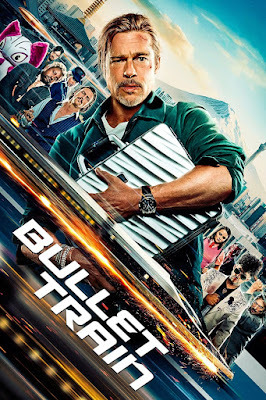Derailing My Train of Thought

Why do so many movies takeplace on trains? Of course there are also a good many car movies and airplanemovies (think The High and the Mighty, also Flight), but Ibelieve passenger trains have a special place in the hearts of filmmakers. Likeairplanes, trains enclose an assorted group of people in a confined space, andpotentially expose them to danger. But trains are, far more than airplanes, in directcontact with the external environment. While a train is in motion,threats—human as well as environmental—can come in from outside. By the sametoken, you can leave a moving train through doors and windows; you can hide ina private compartment, or ride, inmoments of danger, on a train’s roof. And the platforms at train stationsintroduce a wide (and unscreened) mix of people, some of whom might show up forthe sole purpose of causing trouble.
Why am I thinking about this?Partly because a few days back I started to watch Bullet Train (2022),an action comedy toplined by Brad Pitt and a cast of kajillions, virtually allof them assassins pursuing assorted targets aboard a high-speed Japanese train.I didn’t last long—the ultra-chaotic nature of the film soon derailed me—but theexperience got me thinking about trains, both the peaceful long-distance kindthat whisked me from Tokyo to Kansai when I lived in Japan and all the trainsI’ve encountered on movie screens over the years.
And then I found myself on atreadmill at my gym, watching what turned out to be the action climax of the1996 spy film, Mission: Impossible. Yup, it starts off on a passengertrain (in Europe, this time). In pursuitof turncoat spy Jim Phelps, young Ethan Hunt(Tom Cruise) slithers to the roof of a fast-moving train car, where ahelicopter is dangling a cable meant to airlift Phelps (Jon Voigt) to safety. Woeto the chopper pilot, who finds himself (thanks to Hunt’s quick thinking) trappedinside the Chunnel, his whirlybird firmly attached to the train’s roof. Now that’s entertainment!
Not all movie trains aresleek and modern. One of the treasures of the silent period is the 1926 flick, TheGeneral, in which Buster Keaton (who wrote and directed as well as starred)plays a Civil War-era railroad engineer. Thrills blend with comedy as he rescueshis beloved locomotive from invading Union troops, then strategically uses thetrain to ensure a major Confederate victory. A period luxury train is part ofthe fun in both screen versions of Murder on the Orient Express, inwhich a murder in a train sleeping compartment leads to suspicions falling onevery one of the passengers in the car.
At the other end of thespectrum is Snowpiercer (2013), a post-apocalyptic thriller based on aKorean graphic novel. It posits that, as a result of climate change, our planetis uninhabitable. That’s why what’s left of humanity lives permanently on ahuge, globe-circling supertrain that crosses and recrosses what remains of ourfamiliar landscape.
But trains are involved in small,personal stories as well. They’re great places to run up against mysteriousstrangers who can change your life. On atrain you might encounter a spy (Hitchcock’s North by Northwest) or someonewho challenges you to help plan a perfect murder (Hitchcock’s Strangers on aTrain). You might discover yourself stuck amid the dangerous silliness ofthe Ale and Quail Society (Preston Sturges’ The Palm Beach Story). Or you might meet, as in Brief Encounter’strain station, the love of your life.

Beverly in Movieland
- Beverly Gray's profile
- 10 followers



